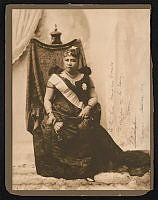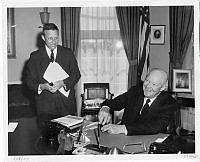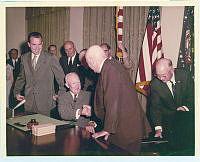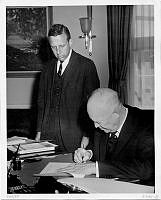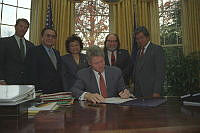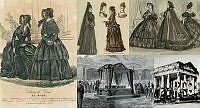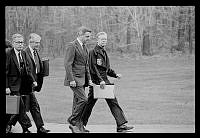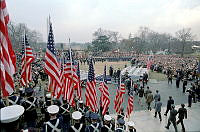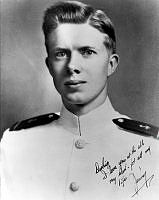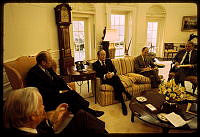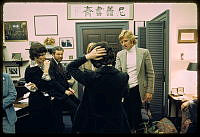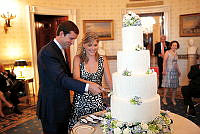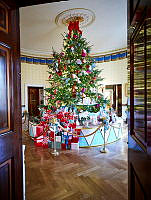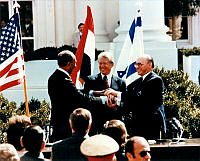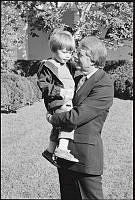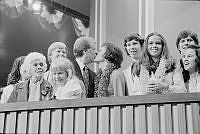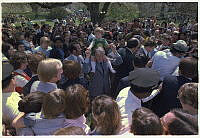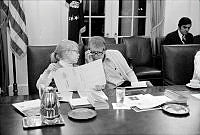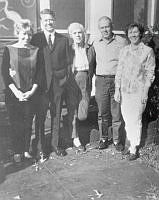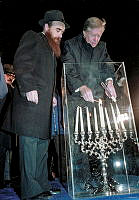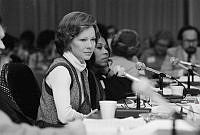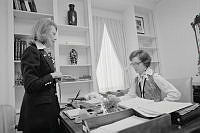Rubenstein Center Scholarship
Hoover's Retreat: Rapidan Camp

Road to President Hoover’s camp on the Rapidan River in August 1929.
Library of CongressNestled in the Blue Ridge Mountains of Virginia, 100 miles from Washington, Camp Rapidan served President Herbert Hoover and First Lady Lou Henry Hoover as a vacation retreat and also a rustic resort center for entertainment of important guests. Rapidan Camp lay 2,550 feet above sea level, and its fresh air drifting through elm, beech and oak trees provided a refreshing difference from the humidity-laden nation’s capital. After White House Chief Usher Ike Hoover visited the camp in 1931, he wrote, “I had no idea such a place could possibly exist up in those wilds.”1
Hoover developed a devotion to fishing during his boyhood in Iowa, fishing for catfish or sunfish on the small Wapsinonoc River in his hometown of West Branch. As president he searched for a place where he could peacefully fish for trout. In April 1929, the president and first lady were taken to a location in Madison County, Virginia in the Blue Ridge and were delighted. They decided to place their presidential retreat there.2
Buy the 2016 Official White House Christmas Ornament
Hoover bought the 164-acre site and also paid $114,000 for the erection of camp buildings of pine board and the clearing of trails and bridle paths for hiking and horseback riding. By September 1929 high-voltage lines had been connected to provide electric power, and telephone, air mail and drainage facilities were installed. Disturbed by newspaper reports that taxpayers were footing the bill, Press Secretary George Akerson indignantly announced that “every nail and stick of wood” used for construction was paid for by Hoover personally.3 On the recommendation of the Department of Agriculture, U.S. Marines trying to kill the camp’s copperheads and rattlesnakes were given a quantity of razorback hogs to help the eradication process.4

The “Brown House,” President and Mrs. Hoover’s large cabin at their Rapidan retreat, which stood on a neck of land where Laurel and Mills Forks joined to form the Rapidan River.
National Park ServiceOn weekends they chose to go to the Blue Ridge, the Hoovers left the White House by car on Friday afternoons; a second car held Secret Service agents; a third, newspaper reporters, a fourth, guests; and a fifth car contained supplies and luggage for their stay.5
The Hoovers’ large cabin, called the Brown House, stood on a neck of land where Laurel and Mills Forks joined to form the Rapidan River and featured a 14-foot wide stone fireplace and mantle built with 51 tons of rocks.6 President Hoover enjoyed fishing and playing with his dogs Weegie and Pat, and guests could participate in archery, baseball, croquet, horseshoes, and lawn tennis. Hoover often brought the work of the presidency with him to the Rapidan camp and frequently conferred with cabinet members, who were assigned their own cabins.
On rainy days a sizable cabin with stone fireplaces, jokingly called the “civic center” or “town hall,” provided guests with a chance to listen to the radio, and play ping-pong and make jigsaw puzzles.7 The first lady made sure her advice to guests was prominently displayed in all the cottages: “After all blankets and eiders are exhausted, put on your camel’s hair dressing gown, wrap your head in a sweater, and throw your fur coat over everything!”8

A porch on a cabin at Camp Rapidan.
National Park ServiceJust three days after the 1930 Virginia fishing season opened, Hoover hurried from the White House to his Rapidan retreat, and was attired in hoop boots in the Rapidan River fishing by 6:00 in the evening. He caught some fish and the camp cook broiled them for a dinner enjoyed by guests including the White House Physician Dr. Joel T. Boone, Commerce Secretary Robert Lamont, Attorney General William Mitchell, and Interior Secretary Ray Lyman Wilbur.9 Hoover used his engineer’s training to contentedly carry small rocks of flint and larger stones into the stream to build pools for the trout.10 Water falling over rocks at the headwaters of the Rapidan afforded a pleasant background sound.11
When the Hoovers learned that local children in the area had no school, the president and some friends paid to have one built in 1930 and also paid the salary of its teacher, Christine Vest, a native of Yosemite, Casey County, Kentucky, and graduate of Berea College with experience teaching at mountain schools in Kentucky and Tennessee. Ms. Vest would continue to teach at the school until her marriage in 1933 to Lou K. Witcofski, one of the U.S. Marines assigned to protect the Rapidan retreat.12

The Hoovers on a footbridge at Camp Rapidan.
National Park ServiceRapidan Camp provided an idyllic reprieve from Washington’s summer heat but could not repel the pressure of the economic depression destroying Hoover’s presidency. Col. Edmund Starling of the White House Secret Service detail recalled that anxiety even pervaded the president’s fishing: “President Hoover grew nervous. His hands would tremble as he worked with his tackle.”13
Hoping to change the widespread public belief that Hoover was a heartless, efficiency-obsessed bureaucrat, White House aides conceived a campaign to “humanize” him. On August 20 reporters and press photographers found themselves welcome at Camp Rapidan to have lunch and record the president fishing in Mills Creek; riding his U.S. Marine Corps gelding “Billy”; posing under trees with a little waterfall burbling in the background; playing with Pat and Weegie; and sitting, book in hand, reading while the first lady sewed.14 The performance for the press went off uneasily. “If nothing else,” one historian of the period has reflected, “the pictures clearly showed … that [Hoover] was bored, irritated, even humiliated. All he wanted was for the men to be gone. Then he could go back to his work.”15
Four weeks after her husband was defeated for reelection, Lou Hoover, her secretary, Philippi Harding Butler, and two friends arrived at Rapidan Camp to begin the sad task of packing up belongings. On the first day of 1933 Hoover transferred the camp’s acreage to the Commonwealth of Virginia. Hoover visited his former retreat for the last time in 1954, ten years before his death. Today Camp Rapidan is located within the boundaries of Shenandoah National Park.16

First Lady Lou Henry Hoover’s Bedroom at Camp Rapidan.
National Park Service












